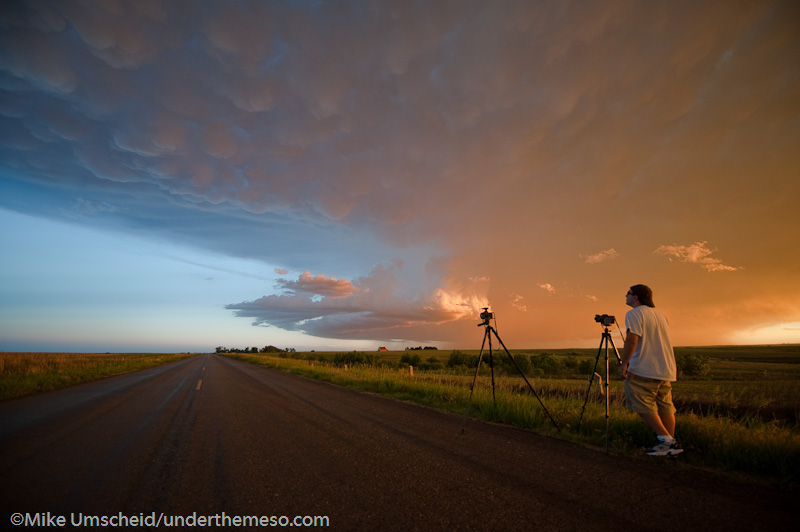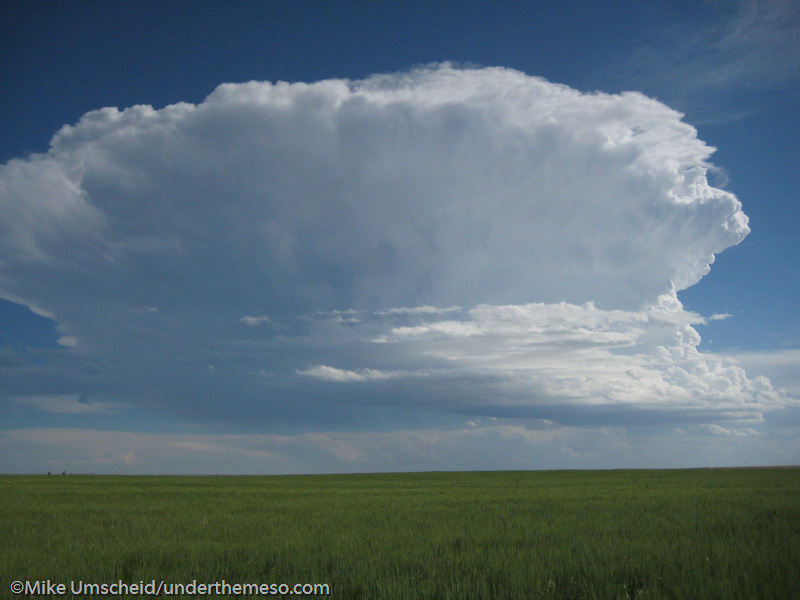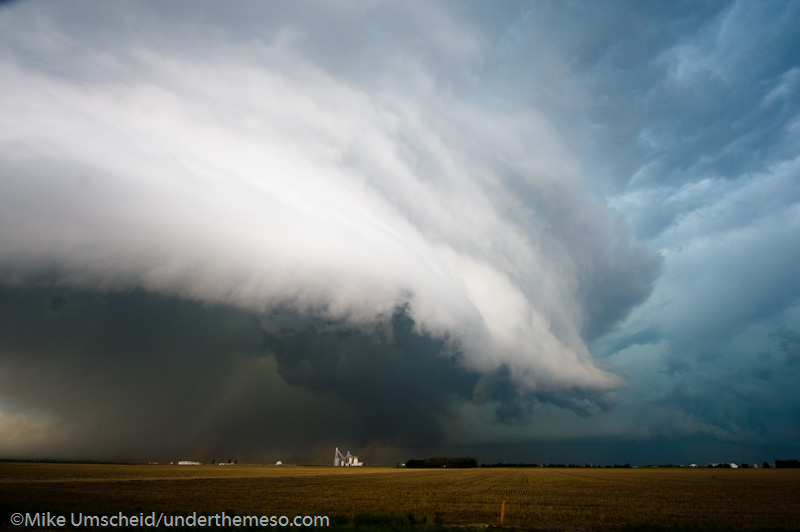The long-lived, significant tornadic supercell of 31 May 2010 will go down as probably my most throroughly and successfully documented significant tornadic supercell in my 13 years of storm chasing. There were three distinct phases of this storm chase, and as such, I will document this account and share my images in 3 parts. The first phase (Part 1 of 3) was the time frame from roughly 2:45pm to 4:30pm which included a 20-minute tornado southwest of Pritchett, Colorado. The second phase was a long period from 4:30pm to about 7:00pm when the supercell was non-tornadic but still cycled through several significant occlusions, one of which was very close to being tornadic (Part 2 of 3). Lastly, the Campo, Colorado significant tornado, the hallmark moment of this supercell, will be documented in Part 3 along with the post-tornado sunset structure as the storm rolled southeast into the Oklahoma Panhandle northeast of Boise City.
Part 1 of 3. 2:30 to 4:30pm CDT (Pritchett, Colorado tornado)


(times CDT unless otherwise noted. numbers in brackets refer to the image number in the embedded image album at the end of this post)
I left Dodge City shortly after 11:00am and decided to head toward Springfield, Colorado. I deliberated for quite awhile… even up until I had to make the turn west of Dodge City… whether to fully commit to the far southeast Colorado target or to head to Lamar first before re-evaluating. I ultimately decided to take the new South Bypass to get on Hwy 56 and eventually 160 (instead of staying on Hwy 50 to go to Lamar). Looking at the visible image and seeing the low stratus across southwest Kansas, eastern Oklahoma, and the eastern Texas Panhandle… with clearing to the west — while there was an absence of thin morning stratus farther north — was a clue to stay south (better, deeper moisture). This was the good kind of morning stratus — the thin stuff the burns off fairly easily by mid-day. Thin, broken stratus on the western plains is a good sign for late day severe weather when there are southeast surface winds and westerly flow aloft… in late May.
Before I even reached Ulysses, KS, towering cumulus was developing in the target area of far eastern Las Animas County between Kim and Pritchett. Instead of taking a leisurely stop and eating lunch, I just grabbed some fast-food and continued on my merry way west to Springfield. I reached Springfield around 1:45pm with a small storm to my west near Pritchett. The initial storms would develop and dissipate only to reform in the same spot. After a quick pit stop in Springfield, I continued west on Hwy 160 to Pritchett. My first stopping point was a couple miles northwest of town on an unpaved county road, where I sat there and watched the genesis of the soon-to-be supercell [1]. I sat there from roughly 2:15 to 2:45pm watching the storm updraft mature to my west a few miles.

Shortly before 3:00pm, I observed the first of two distinct funnel clouds with the initial mesocyclone occlusion looking west from about 4 miles west of Pritchett [2]:
- “persistent well developed funnel cloud about 1/3 to surface from cloud base. too far away to tell if it was a tornado or not, but it was in the cyclonic shear side of the RFD occlusion… it just dissipated at 1:55pm mdt… lasted a couple minutes”
After that SpotterNetwork report, I drifted south and observed the next funnel cloud [3], with its condensation funnel reaching a bit closer to the surface than its predecessor:
- “another funnel cloud at 2:02pm mountain looking west-northwest from my position… 1/2 way to surface possibly a tornado cannot see debris cloud”
A secondary cell was developing immediately south of the original updraft which was producing the funnel clouds..and its rain core was beginning to come over me while on the unpaved road. I made it a point not to go very far off of Hwy 160 just in case it started raining… also making sure that the unpaved road I was on was a hard-surface, well-graded road…which it was… so I made my way east a couple miles to Hwy 160 where I continued south. The time between 3:15 and 3:30pm or so was when the storm was really beginning to blossom with that southern cell now merging with the former cell and essentially taking over.

After a brief bout of nickel size hail and rain, I re-emerged into the inflow sector and was greeted to a nice broadly rotating cloud base lowering to my west. I noticed Roger Hill’s tour group at the corner on 160 south of Pritchett, and I set up shop probably 1/4 of a mile south of him. I sat there from 3:30 to 3:45pm or so before continuing south. In that time, I photographed the storm structure [4,5,6] with, at times, well-developed rotating wall cloud to my west northwest. Inflow at my back facing the wall cloud was sustained 30-40 mph at times from the east-southeast. I had to stand in front of my tripod just to make sure it wouldn’t fall over in the inflow.

I drove south a couple miles to County Road U where I then continued east about one mile in order to get a better view of the overall structure of the supercell. The area of rotation to my northwest a few miles was becoming a little more consolidated [7,8,9] with some semi-transparent precipitation falling in the RFD area of the supercell to the southwest of the wall cloud. At around 3:58pm, a nice laminar funnel developed [10] from the wall cloud which hovered around a third of the way to the ground. In a matter of a minute or two, this funnel was likely making ground contact, although I could not confirm this for sure, but the motion in the funnel cloud, the well-established tip of the condensation funnel and the overall organization of the clear slot… all were a pretty good clue that this was likely a tornado. It was also persistent. [11,12]
- “looking northwest, fairly stout well developed condensation funnel over 1/2 to the surface from my perspective about 5 S Pritchett”
At 4:03pm, the tip of the condensation funnel reach over halfway to the surface from cloud base [13]…and by 4:04pm, a fairly large triangular-shaped condensation funnel was established. I photographed both wide-angle (14 to 18mm on the full frame D3) [14,15] to capture the entire structure with the tornado as well as zoomed-in 50 to 70mm on the DX sensor (Nikon D200) to focus on the tornado itself. Finally, condensation whisps were visible beneath the bowl-shaped condesation funnel at around 4:05pm [16]. At 4:07pm, the tornado was a large bowl-shaped funnel cloud with a small tip condensation funnel with numerous condensation and/or dust whisps looking to the northwest [17]. This then evolved into a more classic truncated cone shape [18,19] with condensation filaments at the tip of the funnel with a small debris cloud beneath at around 4:08pm. The rear-flank downdraft/occlusion was classic from the southeast vantage point…with a hint of aquamarine color around the occluding tornado cyclone at cloud base [20,21,22].

I called the Pueblo NWS office to give them an update on my observation. Right as I was making this call, looking off to the west was another very impressive funnel cloud/likely tornado (given the size/laminar shape of the funnel) [25,26]. This was probably 3 or so miles south of the main tornado looking to my northwest. I believe this was an anticyclonic tornado given its position on the anticyclonic shear side of the rear-flank downdraft. Shortly after I hung up, I posted another SpotterNetwork report:
- “two tornadoes. main tornado looking northwest about a mile or two… and another slender tornado to my west.. photographed both in one frame. main tornado has been periodically on the ground for a number of minutes… perhaps up to 10… it’s a cigar-shaped funnel now with debris whisps observed at times.”
At 4:10pm, the main tornado to the northwest was a vertical cigar-shaped funnel with continued periodic suction spot spin-ups at ground level [29]. I was easily able to capture both tornadoes in one frame with my 14-24mm lens on the D3 [27,28]. The anticyclonic funnel/tornado lasted until about 4:12pm before it finally dissipated. Meanwhile, the main tornado was still in progress to my northwest. The entire storm was moving at a snail’s pace, and I was still sitting at the same location as I was 15 minutes prior watching and photographing this entire event unfold. By 4:15pm, the entire condensation funnel was beginning to shrink and stretch more. Briefly, the condensation funnel reached all the way to the surface at 4:15pm [31,32,33]. The tornado finally dissipated about a minute or so after that — for a total of just under 20 minutes for this tornado. After this tornado dissipated, it was time to reposition.
Part 2 of 3 will document the non-tornadic phase of this incredible supercell storm between 4:30pm and 7:00pm — the moments before the Campo tornado.
This SimpleViewer gallery requires Macromedia Flash. Please open this post in your browser or get Macromedia Flash
here.
This is a
WPSimpleViewerGallery
















































